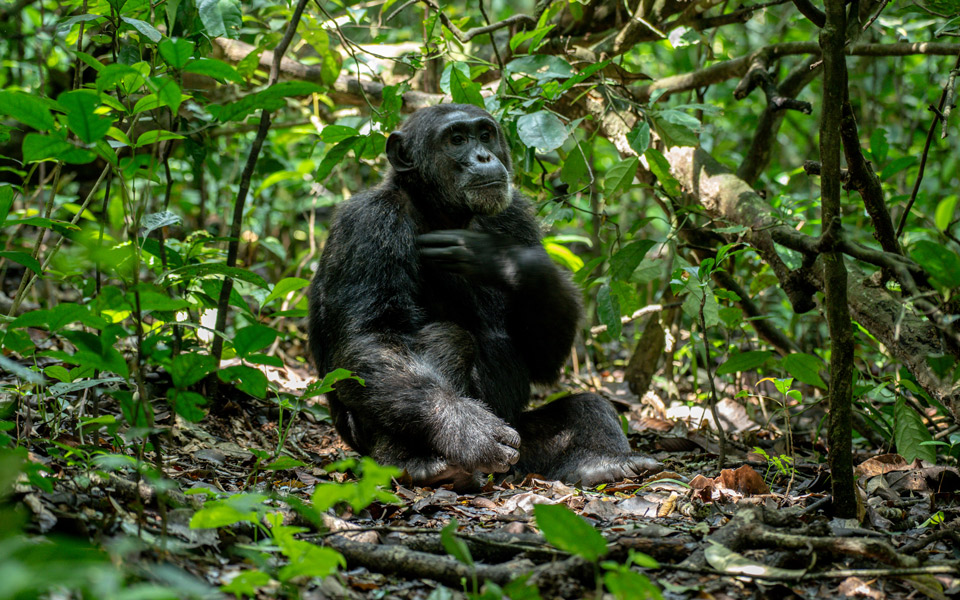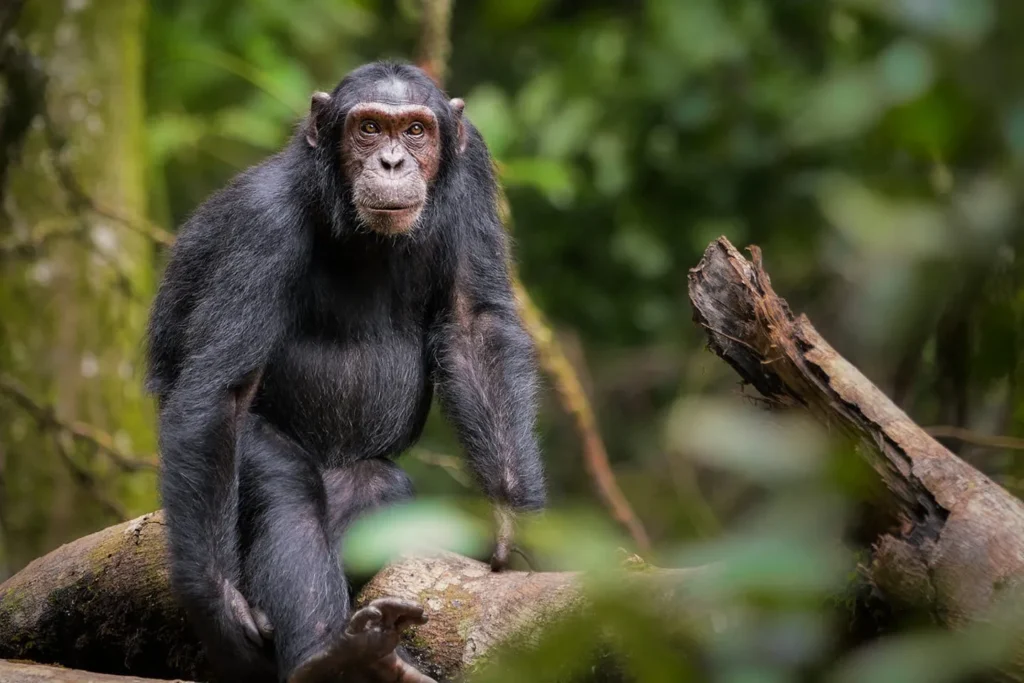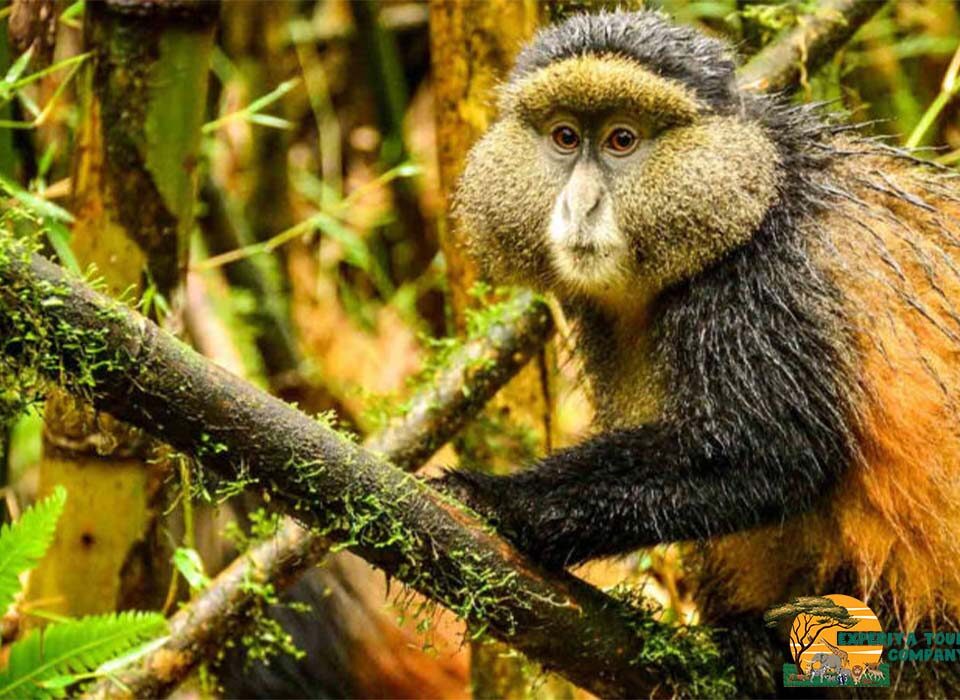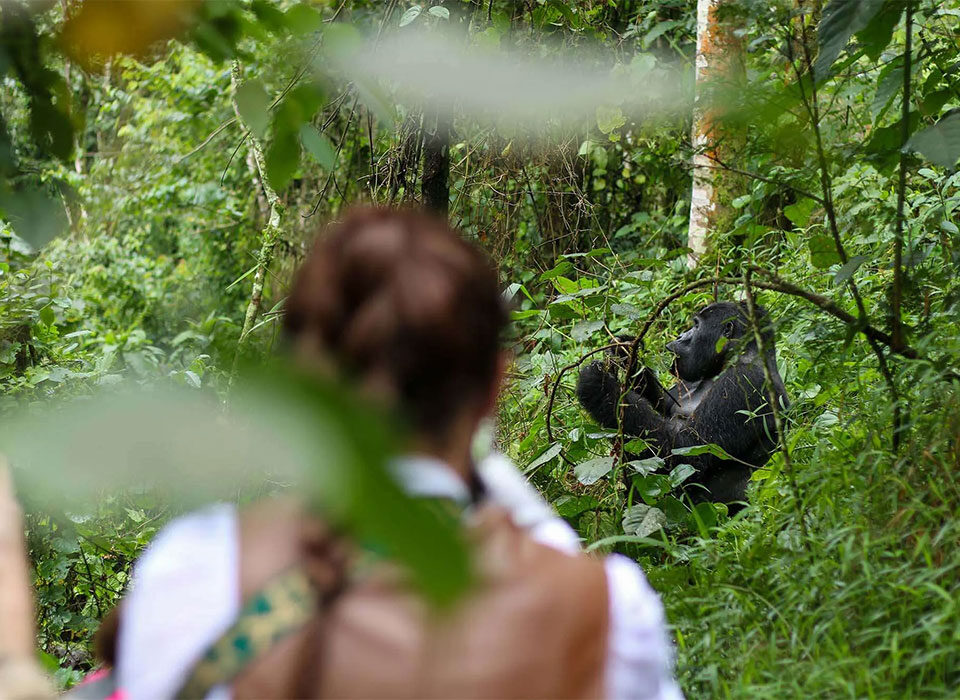
Best Lodges in Queen Elizabeth National Park | Uganda Safari Guide
October 24, 2025
Is Lake Mburo Good for a Short Safari? | Uganda Safari Guide
October 24, 2025Can I See Chimpanzees in Uganda’s National Parks? | Uganda Safari Guide

Can I See Chimpanzees in Uganda’s National Parks?
Uganda, often called the “Pearl of Africa,” is blessed with a stunning range of natural wonders — from snowcapped mountains and lush forests to sprawling savannahs and sparkling lakes. It’s best known around the world for its gorilla trekking adventures in Bwindi Impenetrable National Park, but what many travelers don’t realize is that Uganda is also one of the best places in Africa to see chimpanzees in the wild.
Chimpanzees are our closest relatives, sharing about 98% of our DNA, and observing them in their natural habitat is a deeply moving experience. Their intelligence, complex social behavior, and emotional expressions remind us just how closely connected humans are to the animal kingdom. If you’ve ever dreamed of walking through a tropical forest while listening to the distant calls and playful chatter of chimps, Uganda is the perfect destination.
So, can you see chimpanzees in Uganda’s national parks? The answer is an absolute yes. Uganda is home to several protected areas where chimpanzees thrive, and visitors can join guided tracking excursions to observe them in the wild. Each park offers a unique experience, from dense rainforests to riverine woodlands. Let’s explore the best national parks and reserves in Uganda where you can see chimpanzees and what makes each location special.
Kibale National Park – The Primate Capital of the World
If chimpanzee trekking is on your bucket list, there is no better place to start than Kibale National Park. Often referred to as the Primate Capital of the World, this 795-square-kilometer rainforest in western Uganda is home to the highest concentration of primates in Africa. It shelters more than 1,500 chimpanzees and 12 other primate species, including the red colobus monkey, L’Hoest’s monkey, blue monkey, and grey-cheeked mangabey.
Chimpanzee tracking in Kibale is one of Uganda’s most popular wildlife experiences. The trek begins early in the morning, led by professional Uganda Wildlife Authority (UWA) guides who know the forest intimately. As you move quietly through the thick jungle, you’ll hear the rustling of leaves and the distinctive pant-hooting calls of chimps echoing through the trees. The moment you find them is magical — you may see them grooming, feeding on figs, playing, or swinging effortlessly from branch to branch.
Visitors can choose between two types of experiences here:
- Chimpanzee Tracking: A standard 2- to 3-hour trek that allows you to spend one hour observing a habituated chimpanzee group.
- Chimpanzee Habituation Experience (CHEX): A full-day adventure where you join researchers and rangers as they follow chimps that are still in the process of getting used to human presence. This allows you to witness a broader range of behaviors and interactions.
Kibale’s beauty extends beyond chimpanzees — the park is also a haven for birdwatchers, boasting more than 370 species, and nature lovers can enjoy forest walks, crater lake hikes, and community visits around Bigodi Wetland Sanctuary.
Best time to visit: June to September and December to February are the best months, as trails are drier and chimps are easier to locate.
Queen Elizabeth National Park – The Kyambura Gorge Experience
While Queen Elizabeth National Park is best known for its tree-climbing lions, vast savannahs, and the boat cruises along the Kazinga Channel, it also offers a unique chimpanzee tracking experience in the Kyambura Gorge.
The gorge, often called the “Valley of the Apes,” is a lush, tropical forest sunken dramatically into the golden plains of the park. It’s a striking landscape — a 100-meter-deep chasm carved by the Kyambura River — and it provides one of the most scenic backdrops for chimp tracking in Africa.
Chimpanzees here live in a small but well-habituated population. The trek can be physically demanding as you descend and ascend the steep slopes of the gorge, but it’s an adventure worth taking. Once inside, the atmosphere changes completely — cool, humid air, a canopy of vines and fig trees, and the calls of birds and monkeys all around.
Although the chance of seeing chimps in Kyambura Gorge is slightly lower than in Kibale (due to the smaller population), the experience is breathtaking. Many visitors also encounter black-and-white colobus monkeys, vervet monkeys, and abundant birdlife, including turacos and kingfishers.
The combination of savannah and forest ecosystems in Queen Elizabeth National Park means that visitors can see both primates and big game in one location — making it a top choice for travelers who want diversity in their safari experience.
Best time to visit: The dry seasons (December to February and June to September) provide easier trekking conditions and higher visibility.
Budongo Forest Reserve – A Hidden Gem Near Murchison Falls
Located on the southern edge of Murchison Falls National Park, Budongo Forest Reserve is Uganda’s largest mahogany forest and another top destination for chimpanzee tracking. Managed as part of the greater Murchison Falls conservation area, Budongo is home to around 800 chimpanzees, with one group in the Kaniyo Pabidi sector fully habituated for tourism.
Budongo offers a quieter, more intimate tracking experience than Kibale, with fewer tourists and a serene atmosphere. The forest trails are wide and well-maintained, making the trek less strenuous. As you walk under towering mahogany and ironwood trees, your guide will share fascinating insights about the forest’s ecology, birdlife, and medicinal plants.
When you encounter the chimps, you’ll be struck by how expressive and social they are — mothers tenderly caring for their young, juveniles chasing each other in play, and males drumming on tree trunks to communicate across the forest.
In addition to chimpanzees, Budongo Forest is also famous for birdwatching, with over 350 bird species, including the African dwarf kingfisher and chocolate-backed kingfisher. Visitors can combine a morning of chimp tracking with an afternoon safari or boat cruise in Murchison Falls National Park, making this one of the most rewarding wildlife combinations in Uganda.
Best time to visit: The dry months of December to March and June to August offer the best hiking conditions.
Kalinzu Forest Reserve – A Quiet Alternative
For travelers looking for a lesser-known but equally rewarding chimpanzee experience, Kalinzu Forest Reserve, located near Bushenyi and Queen Elizabeth National Park, is an excellent choice. The forest is home to around 320 chimpanzees, with about 70 of them habituated to human presence.
Kalinzu is managed by the National Forestry Authority (NFA), and guided treks are well-organized, affordable, and led by experienced rangers. The trails meander through beautiful primary and secondary forests, with opportunities to spot other primates like olive baboons, red-tailed monkeys, and black-and-white colobus monkeys.
One of the biggest advantages of Kalinzu is its accessibility and low visitor numbers. The experience feels unhurried and authentic, and sightings are frequent. The area is also rich in birdlife, butterflies, and medicinal plants, making it a fascinating destination for nature lovers.
Many travelers visiting Queen Elizabeth National Park choose to include a side trip to Kalinzu for a more peaceful and less crowded chimpanzee trek.
Best time to visit: Year-round, though the dry seasons make trekking easier and more enjoyable.

Toro-Semliki Wildlife Reserve – Where the Forest Meets the Savanna
Situated in the western Albertine Rift Valley, Toro-Semliki Wildlife Reserve is Uganda’s oldest protected area and one of the most diverse ecosystems in the country. It’s the meeting point of tropical rainforest and open savannah, creating an exceptional environment for both primates and large mammals.
The Semliki Valley is home to a population of chimpanzees that researchers have been studying for decades. What makes this location particularly interesting is that the chimps here are known for their unique behavior — they spend a significant amount of time on the ground and often walk upright more than chimps elsewhere.
While chimpanzee sightings in Toro-Semliki are less predictable compared to Kibale or Budongo, visiting the reserve offers a rare opportunity to see how chimp behavior adapts to a semi-arid environment. In addition, the reserve offers sightings of elephants, buffaloes, and antelopes, as well as over 400 bird species.
For travelers seeking something off the beaten path and scientifically intriguing, Toro-Semliki is a rewarding stop on a primate-focused safari.
Best time to visit: December to February and June to September for dry, accessible roads and better trekking conditions.
Seeing Chimpanzees Beyond the National Parks
Outside of Uganda’s formal national parks and reserves, there are also sanctuaries and conservation centers where you can see and learn about chimpanzees up close.
Ngamba Island Chimpanzee Sanctuary, located on Lake Victoria, provides a home for orphaned and rescued chimps. Visitors can reach the island by boat from Entebbe and observe feeding sessions while learning about chimp rehabilitation and conservation efforts. It’s a perfect stop for travelers beginning or ending their safari in Uganda.
What to Expect During a Chimpanzee Trek
Chimpanzee tracking typically begins early in the morning after a short briefing. Treks can take anywhere from 30 minutes to 3 hours, depending on where the chimps are located that day. Once found, visitors are allowed to spend up to one hour observing them. You’ll need sturdy walking shoes, long trousers, insect repellent, and a camera with good zoom capabilities.
Unlike gorillas, chimps are fast-moving and active, often high up in the trees, which makes photographing them a fun challenge. The experience is both exhilarating and humbling — watching them interact, communicate, and live in complex social groups is like peering into our own evolutionary past.
Recommended Safari Operator: Experiya Tour Company
For travelers planning to see chimpanzees in Uganda, choosing the right safari operator makes all the difference. Experiya Tour Company is one of the most trusted names in Ugandan safaris, offering expertly guided chimpanzee tracking experiences in Kibale, Budongo, Kyambura, and beyond. Their knowledgeable guides provide fascinating insights into chimp behavior, ecology, and conservation, while ensuring a comfortable and safe experience from start to finish.
Experiya also offers tailor-made itineraries that combine chimpanzee tracking with gorilla trekking, wildlife safaris, and cultural encounters, giving you a complete taste of Uganda’s natural and cultural treasures. With their professionalism, attention to detail, and passion for conservation, Experiya Tour Company guarantees a chimpanzee adventure you’ll never forget.



